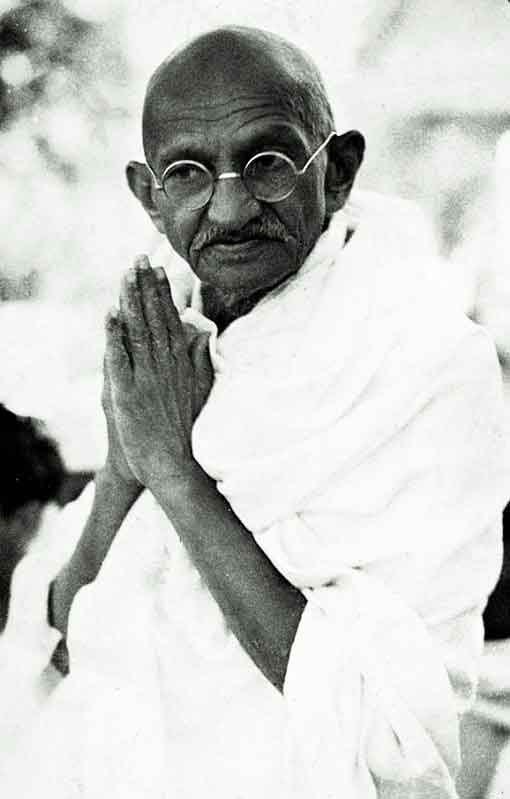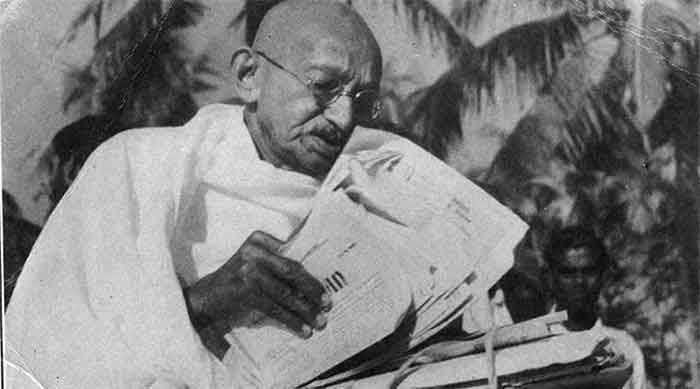
He’s regarded as ‘The Father of the Nation’ and the man who brought down the mightiest global empire without firing a single bullet, yet Gandhi’s ideals and vision go beyond India’s borders and the last century to offer us inspiration and hope. Keith Lyons applauds the Mahatma from New Zealand.

I’ve seen Gandhi everywhere. Not just on my recent trips to India, but also in my native New Zealand, and on television.
Throughout the state of Kerala, during my two-month stint last December and January this year, it seemed that every town featured a prominent tall monument to the pioneering leader, the larger-than-life man who stood just 1.64m tall.
In my New Zealand birthplace, the capital Wellington, a bronze statue of Mahatma Gandhi was unveiled in 2007 in recognition of his non-violent approach to end injustice and free the Indian sub-continent from British colonial rule, as well as the influential man’s simplicity, purity and tolerance.
Gandhi has also featured several times in my favourite television show, the long-running American animated sitcom The Simpsons. In one episode, Gandhi appears next to Homer, protecting him from the murderous intent of Mr Burns, while in another, Bart says he is using non-violent resistance, much to the disgust of his sister Lisa who can’t believe Bart is comparing himself to Mahatma Gandhi.
Also, in The Simpsons Gandhi is wrongly listed as a recipient of the Nobel Peace Prize — he was nominated five times, and the awards committee later regretted never awarding it to the campaigner. To give you an idea of how Gandhi is internationally regarded, in 1999 he was runner up to Albert Einstein as Man of the Century — Gandhi had been named Man of the Year by Time magazine in 1930. There’s another vague approximation moment in ‘The Simpsons’ when Marge declares, “If Gandhi could go without eating for a whole three-hour movie, I can do this.”
While Gandhi is universally acclaimed, and something of an icon for peace and civil disobedience, in India there’s both much admiration and respect for his accomplishments, as well as some criticism for his views on race (and sex), along with the complaint that he was hopelessly unrealistic. Gandhi is still revered as a hero, but it seems regard for the man is more nuanced, reconciling the Westernised lawyer with his frugal lifestyle adopting the clothing style of the poor and khadi.

I attempted to read the hefty 738-page book Gandhi by his grandson Rajmohan Gandhi, pulling it out of the shelves of my local library and holding the substantial tome with both hands hoping not to strain the muscles of my forearms.
However, after reading inside the cover, and admiring the photos of the bespectacled Gandhi, I skipped to the end, to his assassination. One of the conclusions of the book is that the bullets of a Hindu fanatic didn’t kill him. Supporting evidence might include you reading this piece about Gandhi, the longest-running American scripted primetime television series, and some pretty cool spectacles.
During my last trip to India, it was revealed to me just how ubiquitous Gandhi is. At Cochin International Airport, the world’s first airport fully powered by solar energy, I exchange my US dollars for fresh 2,000 and 500 rupees notes, each with a smiling image of Gandhiji.
Gandhi is literally put on a pedestal in Kochi city, frozen in time calmly striding out with his walking stick, while all around the traffic swirls around one of the main roundabouts of the commercial port city. It took me a while, but then I realised why many of the cities I’d visited across India had an ‘M.G. Road’ as its main thoroughfare — and it wasn’t because they were named after M.G., the British sports car.
The other obvious Gandhi-related iconography was the omnipresent image of Gandhi spectacles. Initially, I thought this was something to do with helping poor-sighted people, perhaps some kind of campaign to donating your old reading glasses so someone less fortunate might be able to read.
My misconception was cleared when I listened to the then Union Minister of State for Culture and Tourism, the very approachable Kerala-born Alphons Joseph Kannanthanam, who addressed the 2019 Jaipur Literature Festival (the world’s largest free literary event) outlining the progress of the Swachh Bharat Mission, an ambitious plan to achieve an ‘open-defecation free’ India by the 150th anniversary of Gandhi’s birth. Oh, that was on 2 October last year.
The effort to clean up the streets as well as build millions of toilets flows on from the revolutionary dream of Gandhi, who once declared ‘I want clean India first and independence later’. Officially around 110 million public, community and household toilets have been built across India, though some are not used, and there’s still a long way to go to ease the sanitation woes of a nation of 1,380,004,385 souls, and the social stigma attached to cleaning latrine pits.
I wonder if Gandhi were alive today how he would view the progress towards better sanitation and hygiene, the plight of those urban sewer workers, and the use of his trademark spectacles for the ambitious ‘built-it-and-they-will-come (or dump)’ campaign.
The world’s largest toilet-building and behavioural change initiatives feature just the glasses, not the face of Gandhi. The bridge on the round-frame spectacles of the Swachh Bharat Mission has India’s flag tricolours, reinforcing the patriotic duty to play one’s part — and not to lay a cable outdoors.
Gandhi himself first acquired those steel-frame specs while in London in the 1890s — that style was popular around the turn of the century. Some pairs of his glasses have recently turned up, including a pair from South Africa which fetched over $340,000 at auction in the UK.
For most people outside India, Gandhi’s spectacles have other associations. Seeking to emulate the visionary and pacifist was John Lennon of The Beatles, who wore similar-styled spectacles, and also wanted to have Gandhi on the album cover of Sgt. Pepper’s Lonely Hearts Club Band.
Apple co-founder Steve Jobs wore similar spectacles in tribute to Gandhi. Jobs said that Gandhi was his choice for ‘Person of the Century’ because “he showed us the way out of the destructive side of our human nature”. Gandhi used moral acts of aggression instead of physical acts of aggression to force change and justice. Jobs said, “Never has our species needed this wisdom more”.
For me, Gandhi is an example of what can be achieved in making the world a better place, without the use of force or violence. He believed in creating an ideal society, with full democracy, and freedom. Gandhi ‘walked the talk’ on living a simple life and showed the virtue of patience. More than a century and a half after he was born, his message about the need for religious and political tolerance is just as relevant today. What a man. What a message.
Keith Lyons (keithlyons.net) is an award-winning writer, author and creative writing mentor, with a background in psychology and social sciences. He has been published in newspapers, magazines, websites and journals around the world, and his work was nominated for the Pushcart prize. Keith was featured as one of the top 10 travel journalists in Roy Stevenson’s ‘Rock Star Travel Writers’ (2018). He has undertaken writer residencies in Antarctica and on an isolated Australian island, and in 2020 plans to finally work out how to add posts to his site Wandering in the World (http://wanderingintheworld.com).
Originally published in Borderless Journal
SIGN UP FOR COUNTERCURRENTS DAILY NEWSLETTER















































